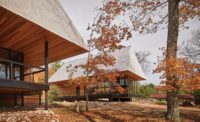I know people will be reading this in crisp October, but as I write I’m hanging on to summer in the week before Labor Day. Summer is a time for many things. One of them, for the right-minded architect, is golf. I realize that I’ll alienate some readers here, but golf and architecture are, I believe, related activities. Golf is said to be an old person’s sport — witness Tom Watson, who almost won the British Open this summer at age 59 — and as we all know, architects, like symphony conductors, tend to flourish in their later years. I.M. Pei was 91 when his museum of Islamic Art recently opened in Qatar.

Mark Twain said, “Golf is a good walk spoiled,” a snotty comment that is usually quoted by people who’ve never picked up that amazingly crafted artifact, a golf club. Twain was seldom wrong, but this time he blew it.
Golf is the only sport that is played in a landscaped garden. A golf course, especially an American one, is the latest and perhaps the final iteration of a great design movement, namely the English country garden of the 18th century, the movement we associate with names like Capability Brown and William Kent. Like Stowe or Stourhead or Rousham, a golf course is an entirely artificial landscape that has been reconfigured in such a way as to resemble the more romantic, naturally sloping meadows of a sheep farm or deer park.
All the old tricks are here: The picturesque grove or single tree sited in exactly the right position to punctuate a view, the rolling contours that seem to be God’s work but are actually the product of shovels or bulldozers, the carefully managed tricks of perspective that make you think you are closer to the putting green than in fact you are, the open axial views to the far horizon (“prospects,” in the language of landscape), or the water feature so placed that it reflects a copper beech against the sky. Even the ha-ha is here, put into service as a hazard that lurks invisibly until you discover it has engulfed your shot. Some golf courses feature actual deer, foxes, or rabbits. I’m talking about the typical inland course, not the “linksland” courses made mostly of sand dunes, which are common in Britain but rare in the U.S.
Golf is not a good walk spoiled. A walk in the country is merely a spectator sport. The viewer is not involved in the scene. But a golfer, like a farmer or a hunter, is deeply engaged with the landscape. And golf is spatial. Your architectural skills come into play. You’re always figuring distances, angles, slopes, textures, winds, maybe the grain of the grass (meaning the direction it’s pointing, which may follow the sun). You’re a kind of land surveyor. If you’re a pro, you will even want to know what variety of grass was planted to surface the greens. You’re alive with all your senses to landscape in all its aspects. Landscape isn’t just there, it matters.


Post a comment to this article
Report Abusive Comment